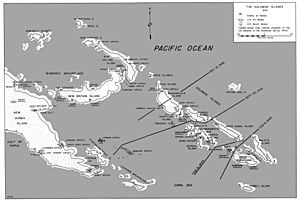Solomon Islands campaign facts for kids
Quick facts for kids Solomon Islands campaign |
|||||||
|---|---|---|---|---|---|---|---|
| Part of the Pacific Theater of World War II | |||||||
 Map of the Solomon Islands showing the Allied advance during 1943 and key air and naval bases. |
|||||||
|
|||||||
| Belligerents | |||||||
• • • |
|||||||
| Commanders and leaders | |||||||
| Casualties and losses | |||||||
| 10,600 killed 40+ ships sunk, 800 aircraft destroyed |
86,000 killed 50+ ships sunk, 1,500 aircraft destroyed (Most of the Japanese deaths were from disease or starvation) |
||||||
The Solomon Islands campaign was a big part of the Pacific War during World War II. It started in early 1942 when Japanese forces landed on several islands. These included parts of the British Solomon Islands and Bougainville in Territory of New Guinea.
The Japanese built naval and air bases on these islands. Their goals were to protect their forces in New Guinea. They also wanted to create a safe area around their main base at Rabaul on New Britain. Plus, they aimed to stop supply ships between the Allied powers, like the United States, Australia, and New Zealand.
To protect their own supply routes, the Allies fought back. They launched attacks in New Guinea and tried to cut off the Japanese base at Rabaul. On August 7, 1942, Allied troops landed on Guadalcanal and nearby islands. This started many battles on land, at sea, and in the air. The fighting continued around New Georgia Island and Bougainville Island.
The Allies slowly wore down the Japanese forces. They caused huge losses that the Japanese could not replace. The Allies took back some of the Solomon Islands. They also surrounded and weakened other Japanese positions. The Solomon Islands campaign then joined with the New Guinea campaign.
Contents
Why the Campaign Happened
World War II in the Pacific
On December 7, 1941, Japan attacked the US Pacific fleet at Pearl Harbor, Hawaii. This surprise attack damaged many US battleships. It started a war between Japan and the United States. Japan also attacked British areas in the Pacific, bringing the United Kingdom, Australia, and New Zealand into the war.
Japan wanted to weaken the US and British navies. They also aimed to take control of places rich in natural resources. They needed military bases to protect their large empire. Japan's main goals were to remove British and American power from the Dutch East Indies and the Philippines. They wanted to become self-sufficient and economically independent.
Japan's Early Successes
In the first six months of the war, Japan achieved its main goals. They captured Hong Kong, the Philippines, Thailand, Malaya, Singapore, and the Dutch East Indies. They also took Wake Island, New Britain, and Guam.
Japan wanted to create a strong defense line. This line would stretch from British India in the west to island bases in the South and Central Pacific. A very important Japanese army and navy base was at Rabaul, New Britain. Japan had captured Rabaul from Australia in January 1942. In March and April, Japanese forces built airfields and naval bases on Bougainville.
Japan Moves into the Solomons
In April 1942, Japan planned to capture Port Moresby in New Guinea. They also planned to take Tulagi in the southern Solomons. Their goal was to expand their control in the South Pacific. They wanted to set up bases to support future attacks on Nauru, Ocean Island, New Caledonia, Fiji, and Samoa. This would cut off supply lines between Australia and the United States.
Japanese naval forces captured Tulagi. However, their attack on Port Moresby failed at the Battle of the Coral Sea. Soon after, the Japanese Navy set up small bases on other northern and central Solomon Islands. One month later, Japan lost four of its aircraft carriers at the Battle of Midway.
Allies Plan Their Counterattack
The Allies built up their troops and aircraft to fight back. They planned to eventually take back the Philippines. In March 1942, Admiral Ernest King of the US Fleet suggested attacking from New Hebrides through the Solomon Islands. After the victory at Midway, General Douglas MacArthur wanted a quick attack to retake Rabaul.
The United States Navy preferred a slower approach. They wanted to advance from New Guinea and up the Solomon Island chain. Leaders decided on a three-part plan. The first part was to capture the island of Tulagi in the Solomons. This became the start of the Solomon Islands campaign.
Key Events of the Campaign
On August 7, 1942, US Marines landed on Guadalcanal. This started the Guadalcanal Campaign. The Allies created a combined air force called the Cactus Air Force. This air force controlled the skies during the day.
The Japanese then used nightly supply missions. They called these "Rat Transportation," but the Allies called them "the Tokyo Express." These missions traveled through New Georgia Sound. Many fierce battles were fought to stop Japanese supplies from getting through. So many ships were sunk by both sides that the area north of Guadalcanal became known as "Ironbottom Sound".
The Allies' success in the Solomon Islands campaign was very important. It stopped Japan from cutting off Australia and New Zealand from the United States. A big Allied plan called Operation Cartwheel, launched in June 1943, helped to isolate Rabaul. It also greatly reduced Japan's power at sea and in the air. This allowed Allied forces to retake the Philippines. This move cut off Japan from important resources in the Netherlands East Indies.
The fighting in the Solomons ended with tough battles in the Bougainville campaign. These battles continued until the very end of the war.
See also
- New Guinea campaign
- New Britain campaign
- Gilbert and Marshall Islands campaign
- Guadalcanal Campaign
- Operation Vengeance
- AirSols
- Battle of the Coral Sea
- Battle of the Treasury Islands

